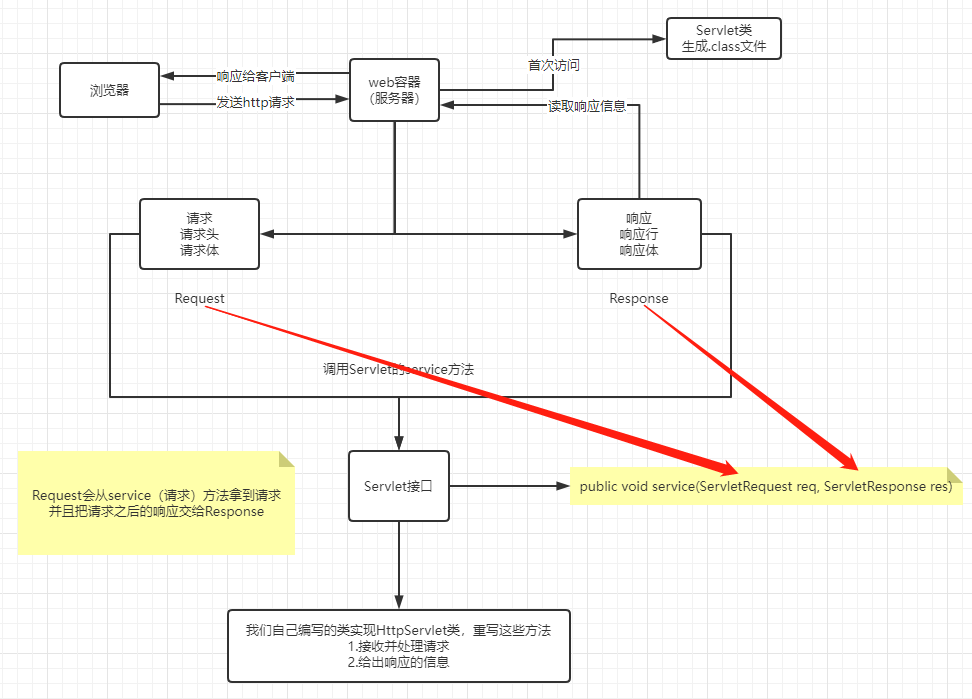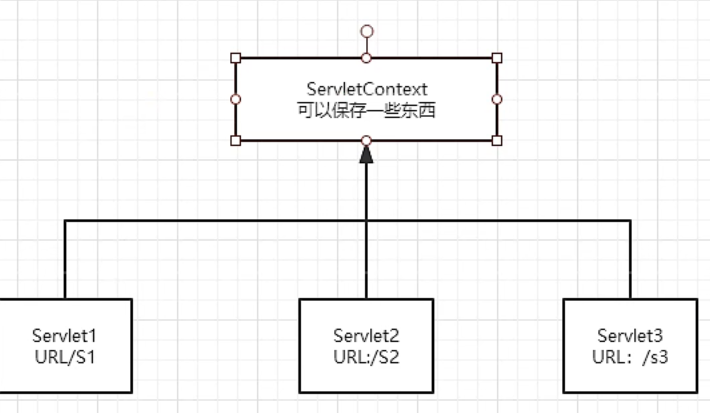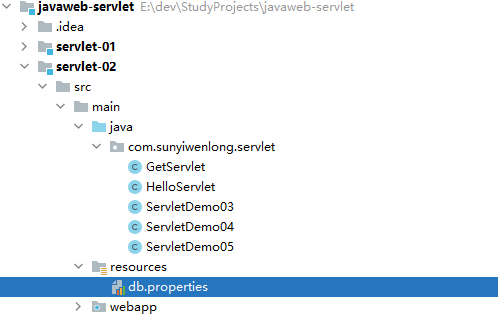Servlet
1. servlet简介
- Servlet就是sun公司开发动态web的一门技术。
- Sun在这些API中提供一个接口叫做:Servlet,如果你想开发一个Servlet程序,只需要完成两个小步骤:
- 编写一个类,实现Servlet接口;
- 把开发好的Java类部署到web服务器中。
把实现了Servlet接口Java程序叫做,Servlet
2. HelloServlet
Serlvet接口Sun公司有两个默认的实现类:HttpServlet,GenericServlet

-
构建一个普通的Maven项目,删掉里面的src目录,以后我们的学习就在这个项目里面建立Moudel;这个空的工程就是Maven主工程;
-
关于Maven父子工程的理解:
父工程中会有:<modules> <module>servlet-01</module> </modules>子项目中会有:
<parent> <artifactId>servlet</artifactId> <groupId>org.example</groupId> <version>1.0-SNAPSHOT</version> </parent>父项目中的jar包,子项目可以直接使用。反之,不可。
Maven环境配置(搭配Tomcat 10)
<dependency> <groupId>jakarta.servlet</groupId> <artifactId>jakarta.servlet-api</artifactId> <version>6.0.0</version> </dependency> <dependency> <groupId>jakarta.servlet.jsp</groupId> <artifactId>jakarta.servlet.jsp-api</artifactId> <version>3.1.1</version> </dependency> -
Maven环境优化
-
编写一个Servlet程序
1.编写一个普通的类
2.实现Servlet接口,这里我们直接继承HttpServlet类package com.hfuuwzy; import jakarta.servlet.ServletException; import jakarta.servlet.http.HttpServlet; import jakarta.servlet.http.HttpServletRequest; import jakarta.servlet.http.HttpServletResponse; import java.io.IOException; import java.io.PrintWriter; public class HelloServlet extends HttpServlet { @Override protected void doGet(HttpServletRequest req, HttpServletResponse resp) throws ServletException, IOException { System.out.println("你好"); PrintWriter writer = resp.getWriter(); writer.print("hello,Servlet!!!"); } @Override protected void doPost(HttpServletRequest req, HttpServletResponse resp) throws ServletException, IOException { super.doPost(req, resp); } } -
编写Servlet的映射
为什么需要映射:我们写的是JAVA程序,但是要通过浏览器访问,而浏览器需要连接web服务器,所以我们需要在web服务中注册我们写的Servlet,还需给他一个浏览器能够访问的路径。<!--注册servlet--> <servlet> <servlet-name>hello</servlet-name> <servlet-class>com.hfuuwzy.HelloServlet</servlet-class> </servlet> <!--Servlet的请求路径--> <servlet-mapping> <servlet-name>hello</servlet-name> <url-pattern>/hello</url-pattern> </servlet-mapping> -
配置tomcat
注意:配置项目发布路径就可以了 -
启动测试
3. Servlet原理

4. Mapping问题
- 一个Servlet可以指定一个映射路径
- 一个Servlet可以指定多个映射路径
- 一个Servlet可以指定通用映射路径
- 指定一些后缀或者前缀等等…
5. ServletContext
web容器在启动的时候,它会为每个web程序都创建一个对应的ServletContext对象,它代表了当前的web应用。
5.1 共享数据
在这个Servlet中保存的数据,可以在另一个Servlet中拿到

存入数据
public class HelloServlet extends HttpServlet {
public void doGet(HttpServletRequest request, HttpServletResponse response) throws IOException {
// this.getInitParameter() 初始化参数
// this.getServletConfig() Servlet配置
// this.getServletContext() Servlet配置上下文
ServletContext servletContext = this.getServletContext();
String username = "王朝阳"; // 数据
servletContext.setAttribute("username",username); // 将一个数据保存在ServletContext中
}
}
读取数据
@WebServlet(name = "getc",value = "/getc") // 此注解可以代替编写xml里的Servlet映射
public class GetServlet extends HttpServlet {
@Override
protected void doGet(HttpServletRequest req, HttpServletResponse resp) throws ServletException, IOException {
ServletContext context = this.getServletContext();
String username = (String) context.getAttribute("username");
resp.setContentType("text/html;charset=utf-8"); // 设置读取的文本风格样式
resp.getWriter().print("名字:"+username);
}
}
5.2 获取初始化参数
<context-param>
<param-name>url</param-name>
<param-value>jdbc:mysql://localhost:3306/mybatis</param-value>
</context-param>
@WebServlet(name = "gp",value = "/gp")
public class ServletDemo03 extends HttpServlet {
@Override
protected void doGet(HttpServletRequest req, HttpServletResponse resp) throws ServletException, IOException {
ServletContext context = this.getServletContext();
String url = context.getInitParameter("url");
resp.getWriter().print(url);
}
}
5.3 请求转发
// 请求/sd4找到ServletDemo04,ServletDemo04进行请求转发到/gp,到/gp的页面
// (浏览器路径是sd4的路径,页面拿到的是/gp的数据)
@WebServlet(name = "sd4", value = "/sd4")
public class ServletDemo04 extends HttpServlet {
@Override
protected void doGet(HttpServletRequest req, HttpServletResponse resp) throws ServletException, IOException {
ServletContext context = this.getServletContext();
System.out.println("进入了servlet04");
RequestDispatcher requestDispatcher = context.getRequestDispatcher("/gp"); // 转发的请求路径
requestDispatcher.forward(req, resp); // 调用forward实现请求转发
}
}
5.4 读取资源文件Properties
- 在java目录下新建properties
- 在resources目录下新建properties发现:都被打包到了同一个路径下:classes,我们俗称这个路径为classpath。
思路:需要一个文件流
@WebServlet(name = "sd5", value = "/sd5")
public class ServletDemo05 extends HttpServlet {
@Override
protected void doGet(HttpServletRequest req, HttpServletResponse resp) throws ServletException, IOException {
InputStream inputStream = this.getServletContext().getResourceAsStream("/WEB-INF/classes/db.properties");
Properties prop = new Properties();
prop.load(inputStream);
String user = prop.getProperty("username");
String pwd = prop.getProperty("password");
resp.getWriter().print(user+":"+pwd);
}
}

6. HttpServletResponse
web服务器接收到客户端的http请求,针对这个请求,分别创建一个代表请求的HttpServletRequest对象,代表响应的一个HttpServletResponse;|
- 如果要获取客户端请求过来的参数:找HttpServletRequest
- 如果要给客户端响应一些信息:找HttpServletResponse
- 负责向浏览器发送数据的方法
public ServletOutputStream getOutputStream() throws IOException;
public PrintWriter getWriter() throws IOException;
-
响应的状态码
public static final int SC_CONTINUE = 100; /** * Status code (200) indicating the request succeeded normally. */ public static final int SC_OK = 200; /** * Status code (302) indicating that the resource has temporarily * moved to another location, but that future references should * still use the original URI to access the resource. * * This definition is being retained for backwards compatibility. * SC_FOUND is now the preferred definition. */ public static final int SC_MOVED_TEMPORARILY = 302; /** * Status code (302) indicating that the resource reside * temporarily under a different URI. Since the redirection might * be altered on occasion, the client should continue to use the * Request-URI for future requests.(HTTP/1.1) To represent the * status code (302), it is recommended to use this variable. */ public static final int SC_FOUND = 302; /** * Status code (304) indicating that a conditional GET operation * found that the resource was available and not modified. */ public static final int SC_NOT_MODIFIED = 304; /** * Status code (404) indicating that the requested resource is not * available. */ public static final int SC_NOT_FOUND = 404; /** * Status code (500) indicating an error inside the HTTP server * which prevented it from fulfilling the request. */ public static final int SC_INTERNAL_SERVER_ERROR = 500; /** * Status code (502) indicating that the HTTP server received an * invalid response from a server it consulted when acting as a * proxy or gateway. */ public static final int SC_BAD_GATEWAY = 502; // ...
常见应用
-
向浏览器输出消息
-
下载文件
@WebServlet(name = "file",value = "/file")
public class FileServlet extends HttpServlet {
@Override
protected void doGet(HttpServletRequest req, HttpServletResponse resp) throws ServletException, IOException {
// 1.要获取下载文件的路径
String realPath = "C:\\Users\\WZY\\Desktop\\大二下\\Web程序设计\\servlet\\response\\src\\main\\resources\\薇尔莉特.png";
System.out.println("下载文件的路径是:" + realPath);
// 2.下载的文件名是啥?
String fileName = realPath.substring(realPath.lastIndexOf("\\") + 1);
// 3.设置想办法让浏览器能够支持下载我们需要的东西
resp.setHeader("Content-Disposition", "attachment;filename=" + URLEncoder.encode(fileName, "utf-8"));
// 4.获取下载文件的输入流
FileInputStream in = new FileInputStream(realPath);
// 5.创建缓冲区
int len = 0;
byte[] buffer = new byte[1024];
// 6.获取OutputStream对象
ServletOutputStream out = resp.getOutputStream();
// 7.将FileOutputStream流写入到bufer缓冲区
while ((len = in.read(buffer)) != -1) {
out.write(buffer, 0, len);
}
in.close();
out.close();
}
// 8.使用OutputStream将缓冲区中的数据输出到客户端!
@Override
protected void doPost(HttpServletRequest req, HttpServletResponse resp) throws ServletException, IOException {
doGet(req, resp);
}
}
- 验证码功能
@WebServlet(name = "img",value = "/img")
public class ImageServlet extends HttpServlet {
@Override
protected void doGet(HttpServletRequest req, HttpServletResponse resp) throws ServletException, IOException {
// 让浏览器3秒刷新一次
resp.setHeader("refresh", "3");
// 在内存中创建一个图片
BufferedImage image = new BufferedImage(80, 20, BufferedImage.TYPE_INT_RGB);// 宽、高、颜色
// 得到图片
Graphics2D g = (Graphics2D) image.getGraphics();// 得到一只2D的笔
// 设置图片的背景颜色
g.setColor(Color.white);
g.fillRect(0, 0, 80, 20);// 填充颜色
// 换个背景颜色
g.setColor(Color.BLUE);
// 设置字体样式:粗体,20
g.setFont(new Font(null, Font.BOLD, 20));
// 画一个字符串(给图片写数据)
g.drawString(makeNum(), 0, 20);
// 告诉浏览器,这个请求用图片的方式打开
resp.setContentType("image/jpeg");
// 网站存在缓存,不让浏览器缓存
resp.setDateHeader("expires", -1);
resp.setHeader("Cache-Control", "no-cache");
resp.setHeader("Pragma", "no-cache");
// 把图片写给浏览器
boolean write = ImageIO.write(image, "jpg", resp.getOutputStream());
}
// 生成随机数
private String makeNum() {
Random random = new Random();
String num = random.nextInt(9999999) + "";// 随机数,最大七位,[0,9999999)
StringBuffer sb = new StringBuffer();
for (int i = 0; i < 7 - num.length(); i++) {// 不足七位,则添加0
sb.append("0");
}
num = sb.toString() + num;// 不足七位,在随机数前面添加0
return num;
}
@Override
protected void doPost(HttpServletRequest req, HttpServletResponse resp) throws ServletException, IOException {
doGet(req, resp);
}
}
-
实现请求重定向
@WebServlet(name = "Red", value = "/red") public class RedirectServlet extends HttpServlet { @Override protected void doGet(HttpServletRequest req, HttpServletResponse resp) throws ServletException, IOException { /* resp.setHeader("Location","/res/image"); resp.setStatus(302); */ resp.sendRedirect("/res/img"); } @Override protected void doPost(HttpServletRequest req, HttpServletResponse resp) throws ServletException, IOException { doGet(req, resp); } }
7. HttpServletRequest
HttpServletRequest代表客户端的请求,用户通过Http协议访问服务器,HTTP请求中的所有信息会被封装到HttpServletRequest,通过这个HttpServletRequest的方法,获得客户端的所有信息。
-
获取前端传递的参数

-
请求转发
前端:<%@ page contentType="text/html; charset=UTF-8" pageEncoding="UTF-8" %> <!DOCTYPE html> <html> <head> <title>登录</title> </head> <body> <h1>登录</h1> <div > <%--这里表单表示的意思:以post方式提交表单,提交到我们的login请求--%> <form action="${pageContext.request.contextPath}/login" method="post"> 用户名:<input type="text" name="username"><br> 密码:<input type="password" name="password"><br> 爱好: <input type="checkbox" name="hobbys" value="代码"> 代码 <input type="checkbox" name="hobbys" value="唱歌"> 唱歌 <input type="checkbox" name="hobbys" value="女孩"> 女孩 <input type="checkbox" name="hobbys" value="电影"> 电影 <br> <input type="submit" name="提交"> </form> </div> </body> </html>后端:
@WebServlet(name = "LoginServlet",value = "/login") public class LoginServlet extends HttpServlet { @Override protected void doGet(HttpServletRequest req, HttpServletResponse resp) throws ServletException, IOException { String username = req.getParameter("username"); String password = req.getParameter("password"); String[] hobbys = req.getParameterValues("hobbys"); System.out.println("------------------------"); System.out.println(username); System.out.println(password); System.out.println(Arrays.toString(hobbys)); // 通过请求转发 // resp.sendRedirect("/req/success.jsp"); req.getRequestDispatcher("/success.jsp").forward(req,resp); // 转发 / 代表当前的web应用,直接跟路径名称就行,与重定向不一样 } @Override protected void doPost(HttpServletRequest req, HttpServletResponse resp) throws ServletException, IOException { doGet(req, resp); } }
面试题:请你聊聊重定向和转发的区别?
相同点:页面都会实现跳转
不同点:
- 请求转发的时候,url地址栏不会产生变化。307
- 重定向时候,url地址栏会发生变化。302


 浙公网安备 33010602011771号
浙公网安备 33010602011771号